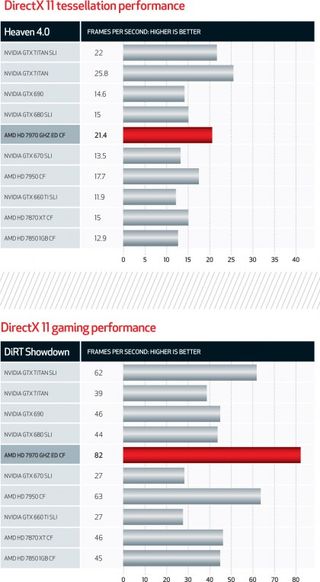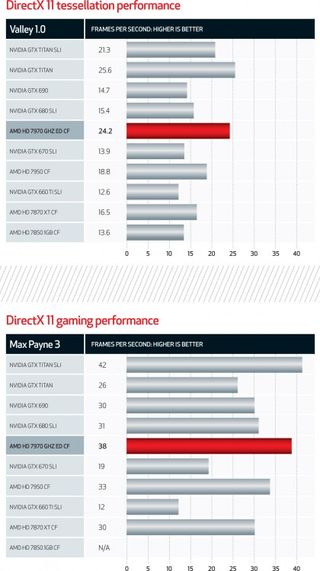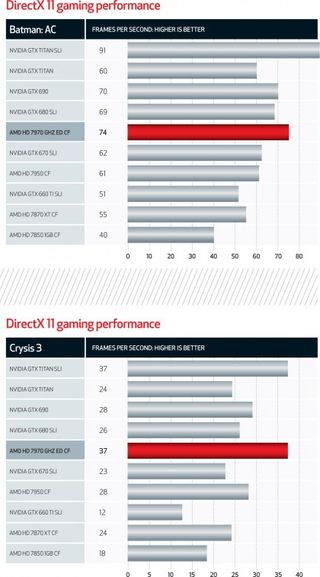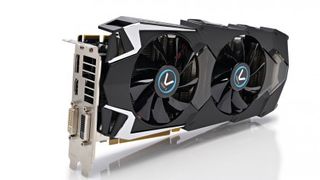Best high resolution and multi GPU graphics cards: 10 reviewed
One GPU or two? That is the question
Benchmark analysis
It's all about the numbers
All the tests here were performed on our über test rig comprising an Asus X79 Rampage IV Extreme with a Xeon E5-2687 eight-core CPU and 16GB Corsair 2,133MHz RAM. We used three 22-inch Iiyama screens to make up our triple-screen setup, and benchmarked all our games and synthetic tests at an eye-watering 5,885 x 1,080 resolution.
All the gaming benchmarks ran happily with our multi-GPU/multiscreen setups, though both the Unigine synthetic tests - Heaven and Valley - performed worse with twin GPUs in a surround setup.



And the winner is… AMD HD 7970 GHZ ED CF

The purpose of this test isn't to encourage you to go out and blow your life savings on a triumvirate of screens and a new set of graphics cards so you can indulge in a triple-screen setup. I think we've established that's a gaming array that only those with an enormous disposable income could consider because of the limited benefits and massive performance premium it entails.
No, the point of this test is to see how the current crop of graphics cards is set for a future beyond our current resolution limits. We still test all our hardware at the max 30-inch res of 2,560 x 1,600, but with 3D pretty much dead and buried, the next push for TVs and console hardware is going to be towards 4K.
The 3,840 x 2,160 resolution that 4K represents is the goal for hardware manufacturers wanting to move beyond HD. When the original HD consoles launched, 1080p as a standard seemed a long way off, but it's become the norm. Now the next generation is on the way and is targeting 4K, so that should become the gaming standard a little way down the line.
We stuck three screens together in a 5,885 x 1,080 surround setup to give us a bit of a yardstick. The 4K res is around eight megapixels (MP), while our triple-screen array is just over 6MP, and it has to be said that while it's definitely punishing, our current multi-GPU setups can cope admirably.
The winner though has to be AMD's HD 7970 GHz Edition in CrossFireX trim. The performance is astonishing compared with what Nvidia's finest can do with a £1,600 SLI pairing, and shows how smart the Texans have been by dropping an unprecedented 3GB GDDR5 with a 384-bit bus onto their top two cards.
That said, the setup woes of AMD's multi-GPU/multi-screen tech almost tainted my view of the performance figures. You know there will be times when that game you're desperate to play on day one simply wont work with this setup.
That's where Nvidia's GTX Titan comes in. It's nowhere near the fastest here, but no other single-GPU card is capable of consistently throwing around polygons at this resolution at those sorts of speeds. Because it's a single card there's less worry about day one driver problems, and Nvidia hasn't put a third of its eggs in the DisplayPort basket either, so it's more versatile for a multi-screen setup too.
So there's the experience vs raw performance argument in a nutshell, and if the test stopped there that would be all I'd write, but the second-tier AMD cards are almost as capable as the top-tier at this resolution, and are far cheaper than the GTX Titan on its own.
Other than the Titan, there really isn't a place here for the Nvidia cards at such high resolutions. The smaller memory capacities and weaker memory buses hobble its cards once you move past 2,560 x 1,600, and when you factor in the lower prices, AMD's claims to GPU leadership in this generation certainly bear fruit.
Get the best Black Friday deals direct to your inbox, plus news, reviews, and more.
Sign up to be the first to know about unmissable Black Friday deals on top tech, plus get all your favorite TechRadar content.
